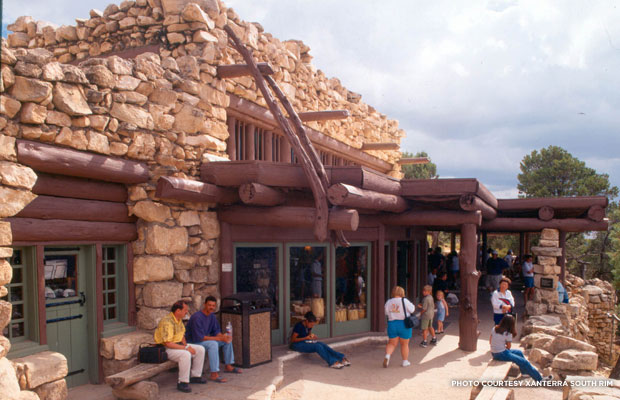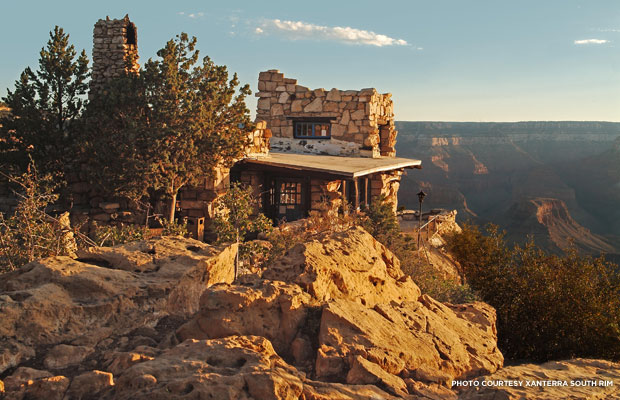Grand Canyon's Hermit's Rest and Lookout Studio Turn 100

Lookout Studio is located on the Grand Canyon’s South Rim and offers breathtaking views for photographers to take advantage of.
A hundred years ago, the Wild West was growing tamer by the day. Starting in the late 19th century, for the first time in American history, curious East Coasters could take a trip through the region’s exotic landscapes for the price of a train ticket. A brand-new hospitality industry quickly sprang up to accommodate them -- and that’s where two rustic buildings designed by pioneering architect Mary Colter come in.
Hermit’s Rest and Lookout Studio, both located in what is now Grand Canyon National Park, are turning 100 this year. While the West has since grown even more tame, Colter's buildings remain largely unchanged, still offering a place for weary travelers to kick up their feet and admire the view.
“All of Mary Colter’s buildings were established as guest facilities,” says Bruce Brossman of Xanterra Parks & Resorts, the company in charge of guest services in the national park. Colter was employed by the Fred Harvey Company, a hospitality business that worked in conjunction with the Santa Fe Railway to offer comfortable dining and accommodations to passengers and tourists along the railroad line and at attractions like the Grand Canyon. Brossman estimates that there are roughly a dozen Colter-designed properties in the national park.
“Back in those days, visitors came from the East Coast and they stayed longer,” Brossman says. “It wasn’t a 3-hour visit like it was today. The Fred Harvey Company built the road out to Hermit’s Rest, and once [tourists] got out there, they got refreshments.”

Hermit’s Rest, designed to look like it was constructed by a fictional mountain man, still serves as a rest spot for visitors today.
As an architect, Colter was known for incorporating a strong sense of history into her creations. Hermit’s Rest, located at the westernmost point on the canyon’s South Rim and accessible by a paved road, was built to evoke a dwelling constructed by a fictional mountain man using the area’s natural timber and boulders. The Native American-inspired Lookout Studio, perched on the rim of the canyon west of the El Tovar Hotel, offers breathtaking views through its windows.
“[Hermit's Rest] looks very informal,” says Arnold Berke, author of Mary Colter: Architect of the Southwest and contributing editor to Preservation magazine. “It’s so haphazard, and it looks like it was about to fall into the canyon. Lookout Studio looks like it’s growing up and out of the canyon. In both cases, in your first glance at them, you think, ‘This is really part of the landscape here.’”
Colter began working for the Fred Harvey Company in 1902 at the age of 33, and was employed there for the next 46 years. She carefully and lovingly designed what amounted to rest stops, lookouts, and lodging in the Grand Canyon, like Phantom Ranch and the South Rim’s Hopi House, as well as grander structures like the El Navajo Hotel in Gallup, New Mexico, and, later in her career, a sleek and modern cocktail lounge at Union Station in Los Angeles.

Colter, who was known to draw inspiration from the natural landscape, designed Lookout Studio to resemble Native American dwellings.
Apart from being visionary and innovative, Colter also earned a reputation for being a perfectionist.
“She was tough – she would have to have been,” Brossman says. “She supervised the building of every one of those buildings. Every rock, every detail she had a hand in.”
While she wasn’t well-known during her lifetime, her contributions to rustic architecture have recently become more widely recognized.
“Especially in her natural landscape [of the Southwest,] she really created a path to future design in the National Parks,” says Berke.
Hermit’s Rest is accessible by bus, shuttle, bike, and on foot. During the winter months, the Hermit’s Trail road is also open to private vehicles. Lookout Studio is a stop on a self-guided walking tour of the Grand Canyon Village Historic District, and is open year-round.
A planned interior renovation of Lookout Studio will make the inside more closely match Colter’s original design, and Brossman says that Xanterra is committed to maintaining and preserving both buildings and keeping them in good condition.
“They are a very important part of the human history of the Grand Canyon,” he says. By visiting structures like Hermit's Rest and Lookout Studio, future generations of Grand Canyon visitors will be able to feel the same sense of wonder as those first East Coast tourists, stepping off the train and catching sight of the new American West.



.webp)